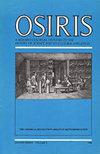制作中国复制品:二十世纪初全球科学和资本主义的商标和配方
IF 1
3区 哲学
Q2 HISTORY & PHILOSOPHY OF SCIENCE
引用次数: 4
摘要
这篇文章探讨了20世纪初关于中国涉嫌抄袭巴勒斯威康公司Hazeline Snow消失霜的商标和品牌配方的国际争端。通过这样做,它探讨了大都市制造商和殖民地周边行为者在谈判新兴全球商标制度的参数时发生的复杂来回。这篇文章并没有将中国品牌商标和配方的改编者描述为简单的不道德的造假者或帝国侵略的被动受害者,而是将他们视为关于商标所有权、制造和化学知识问题的全球辩论的充分参与者。此外,由于中国对商标的改编和品牌配方的流通是“常识”,Burroughs Wellcome and Company动员新兴工业产权制度的商标法来阻止改编后的商标和配方的传播。因此,该公司对商标法的部署是一个例子,说明了一家资本主义公司如何通过阻碍所谓的资本主义“自由市场”来确保其在竞争激烈的制药市场中的优势,并阻碍化学和制造知识的任何公开流通。这些发现使我们能够完善最近对现代科学和资本主义历史分析中经常使用的“流通”的强调。本文章由计算机程序翻译,如有差异,请以英文原文为准。
Making the Chinese Copycat: Trademarks and Recipes in Early Twentieth-Century Global Science and Capitalism
This essay examines early twentieth-century international disputes over alleged Chinese copying of the trademarks and brand recipes of Burroughs Wellcome and Company’s Hazeline Snow vanishing cream. By doing so, it explores the complex back-and-forth that occurred between metropole manufacturers and actors in the colonial periphery in negotiating the parameters of a newly emerging global trademark regime. The essay does not present Chinese adapters of brand trademarks and recipes as simply unethical counterfeiters or passive victims of imperial aggression but treats them as full participants in a global debate over questions of ownership of commercial marks and manufacturing and chemical knowledge. Furthermore, because of Chinese adaptation of marks and circulation of brand recipes as “common knowledge,” Burroughs Wellcome and Company mobilized the trademark law of the newly emerging industrial property regime to halt the travel of adapted marks and recipes. The company’s deployment of trademark law thus serves as an example of how a capitalist corporation sought to ensure its advantage in competitive pharmaceutical markets by obstructing the purportedly “free markets” of capitalism and to stymie any open circulation of chemical and manufacturing knowledge. Such findings allow us to refine the recent emphasis on “circulation” often used in the historical analysis of modern science and capitalism.
求助全文
通过发布文献求助,成功后即可免费获取论文全文。
去求助
来源期刊

Osiris
管理科学-科学史与科学哲学
CiteScore
1.10
自引率
0.00%
发文量
18
审稿时长
>12 weeks
期刊介绍:
Founded in 1936 by George Sarton, and relaunched by the History of Science Society in 1985, Osiris is an annual thematic journal that highlights research on significant themes in the history of science. Recent volumes have included Scientific Masculinities, History of Science and the Emotions, and Data Histories.
 求助内容:
求助内容: 应助结果提醒方式:
应助结果提醒方式:


